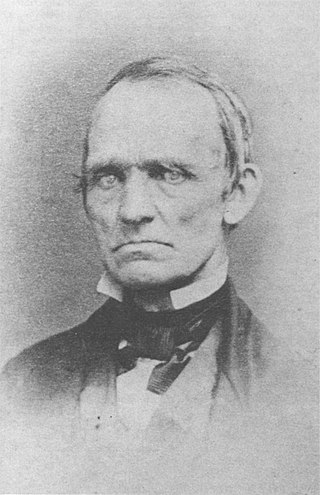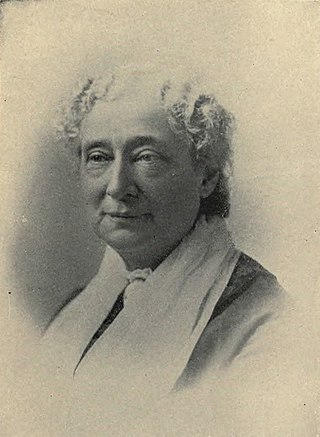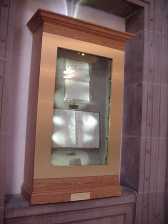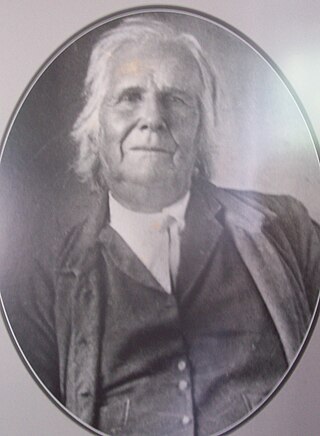Related Research Articles

Thomas Riley Marshall was an American politician who served as the 28th vice president of the United States from 1913 to 1921 under President Woodrow Wilson. A prominent lawyer in Indiana, he became an active and well known member of the Democratic Party by stumping across the state for other candidates and organizing party rallies that later helped him win election as the 27th governor of Indiana. In office, he attempted to implement changes from his progressive agenda to the Constitution of Indiana, but his efforts proved controversial and were blocked by the Indiana Supreme Court.

Thomas Andrews Hendricks was an American politician and lawyer from Indiana who served as the 16th governor of Indiana from 1873 to 1877 and the 21st vice president of the United States from March until his death in November 1885. Hendricks represented Indiana in the U.S. House of Representatives (1851–1855) and the U.S. Senate (1863–1869). He also represented Shelby County, Indiana, in the Indiana General Assembly (1848–1850) and as a delegate to the 1851 Indiana constitutional convention. In addition, Hendricks served as commissioner of the United States General Land Office (1855–1859). Hendricks, a popular member of the Democratic Party, was a fiscal conservative. He defended the Democratic position in the U.S. Senate during the American Civil War and Reconstruction era and voted against the Thirteenth, Fourteenth, and Fifteenth Amendments to the U.S. Constitution. He also opposed Radical Reconstruction and President Andrew Johnson's removal from office following Johnson's impeachment in the U.S. House.

Corydon is a town in Harrison Township, Harrison County, Indiana. Located north of the Ohio River in the extreme southern part of the US state of Indiana, it is the seat of government for Harrison County. Corydon was founded in 1808 and served as the capital of the Indiana Territory from 1813 to 1816. It was the site of Indiana's first constitutional convention, which was held June 10–29, 1816. Forty-three delegates convened to consider statehood for Indiana and drafted its first state constitution. Under Article XI, Section 11, of the Indiana 1816 constitution, Corydon was designated as the capital of the state, which it remained until 1825, when the seat of state government was moved to Indianapolis. In 1863, during the American Civil War, Corydon was the site of the Battle of Corydon, the only official pitched battle waged in Indiana during the war. More recently, the town's numerous historic sites have helped it become a tourist destination. A portion of its downtown area is listed in the National Register of Historic Places as the Corydon Historic District. As of the 2010 census, Corydon had a population of 3,122.

The Indiana Territory, officially the Territory of Indiana, was created by an organic act that President John Adams signed into law on May 7, 1800, to form an organized incorporated territory of the United States that existed from July 4, 1800, to December 11, 1816, when the remaining southeastern portion of the territory was admitted to the Union as the state of Indiana. The territory originally contained approximately 259,824 square miles (672,940 km2) of land, but its size was decreased when it was subdivided to create the Michigan Territory (1805) and the Illinois Territory (1809). The Indiana Territory was the first new territory created from lands of the Northwest Territory, which had been organized under the terms of the Northwest Ordinance of 1787. The territorial capital was the settlement around the old French fort of Vincennes on the Wabash River, until transferred to Corydon near the Ohio River in 1813.

James Brown Ray was an Indiana politician and the only Indiana Senate president pro tempore to be elevated to governor of the state of Indiana. Ray served during a time when the state transitioned from personal politics to political parties, but never joined a party himself. Taking office one week before his 31st birthday, he became the state's youngest governor and served from 1825 to 1831, the longest period for an Indiana governor under the state constitution of 1816. During Ray's term as governor the state experienced a period of economic prosperity and a 45 percent population increase. He supported projects that encouraged the continued growth and development of the young state, most notably internal improvements, Native American removal, codification of Indiana's laws, improved county and local government, and expanded educational opportunities. Ray was known for his eccentricity and early promotion of a large-scale railroad system in the state. His support for new railroad construction and alleged involvement in several scandals caused him to lose popularity among voters. Ray's opponents who favored the creation of canals considered railroads to be an impractical, utopian idea. Following Ray's departure from political office, he continued to advocate for a statewide railroad system until his death in 1848.

Jonathan Jennings was an American politician who was the first governor of the State of Indiana and a nine-term congressman from Indiana. Born in either Hunterdon County, New Jersey, or Rockbridge County, Virginia, he studied law before migrating to the Indiana Territory in 1806. Jennings initially intended to practice law, but took jobs as an assistant at the federal land office at Vincennes and assistant to the clerk of the territorial legislature to support himself and pursued interests in land speculation and politics. Jennings became involved in a dispute with the territorial governor, William Henry Harrison, that soon led him to enter politics and set the tone for his early political career. In 1808 Jennings moved to the eastern part of the Indiana Territory and settled near Charlestown, in Clark County. He was elected as the Indiana Territory's delegate to the U.S. Congress by dividing the pro-Harrison supporters and running as an anti-Harrison candidate. By 1812, he was the leader of the anti-slavery and pro-statehood faction of the territorial government. Jennings and his political allies took control of the territorial assembly and dominated governmental affairs after the resignation of Governor Harrison in 1812. As a congressional delegate Jennings aided passage of the Enabling Act in 1816, which authorized the organization of Indiana's state government and state constitution. He was elected president of the Indiana constitutional convention, held in Corydon in June 1816, where he helped draft the state's first constitution. Jennings supported the effort to ban slavery in the state and favored a strong legislative branch of government.

William Hendricks was a Democratic-Republican member of the House of Representatives from 1816 to 1822, the third governor of Indiana from 1822 to 1825, and an Anti-Jacksonian member of the U.S. Senate from 1825 to 1837. He led much of his family into politics and founded one of the largest political families in Indiana. He was the uncle of Thomas Andrews Hendricks, who was also Governor of Indiana and Vice President of the United States. Hendricks County was named in his honor. His term as governor was spent repairing the state's finances to later enable large scale internal improvements. The establishment of the basic framework of the state's public school system and the transfer of the capital from Corydon to Indianapolis also occurred during his term.

Samuel Merrill, a native of Peacham, Vermont, was an early lawyer and leading citizen of Indiana, who served as state treasurer from 1822 to 1834. Merrill attended Dartmouth College, and in 1816 settled in Vevay, Indiana, where he established a law practice and served in the Indiana General Assembly as a representative from Switzerland County (1821–22). Merrill resigned his position as state treasurer in 1834 to become the president of the State Bank of Indiana (1834–44); he also served as the president of the Madison and Indianapolis Railroad Company (1844–48) and head of the Merrill Publishing Company, which later became the Bobbs-Merrill Company. In addition to his government service and business ventures, Merrill was the second president of the Indiana Historical Society (1835–48), a founder and trustee of Wabash College, and an elder in the Second Presbyterian and Fourth Presbyterian churches in Indianapolis.

Robert Hanna Jr. is best known as one of the forty-three delegates to the 1816 Indiana Constitutional Convention and Indiana's third U.S. Senator after it achieved statehood in 1816. A native of Laurens County, South Carolina, he settled in the Indiana Territory shortly after it was established in 1800 and began his long career as a public servant in Brookville, Indiana. Hanna served as the first Franklin County sheriff (1809–20), as a brigadier general in the state militia, and as the United States General Land Office registrar in Brookville and Indianapolis (1820–30). Hanna was appointed to fill the vacant seat in the U.S. Senate following the death of James Noble in 1831. Hanna served in the U.S. Senate from August 19, 1831, to January 3, 1832. After his return to Indianapolis, Hanna represented Marion County in the Indiana House of Representatives and in the Indiana Senate.

Zerelda Gray Sanders Wallace was the First Lady of Indiana from 1837 to 1840, and a temperance activist, women's suffrage leader, and inspirational speaker in the 1870s and 1880s. She was a charter member of Central Christian Church, the first Christian Church in Indianapolis, Indiana. Her husband was David Wallace, the sixth governor of Indiana; Lew Wallace, one of her stepsons, became an American Civil War general and author.

The Corydon Historic District is a national historic district located in Corydon, Indiana, United States. The town of Corydon is also known as Indiana's First State Capital and as Historic Corydon. The district was added to the National Register of Historic Places in 1973, but the listing was amended in 1988 to expand the district's geographical boundaries and include additional sites. The district includes numerous historical structures, most notably the Old Capitol, the Old Treasury Building, Governor Hendricks' Headquarters, the Constitution Elm Memorial, the Posey House, the Kintner-McGrain House, and The Kintner House Inn, as well as other residential and commercial sites.

The history of human activity in Indiana, a U.S. state in the Midwest, stems back to the migratory tribes of Native Americans who inhabited Indiana as early as 8000 BC. Tribes succeeded one another in dominance for several thousand years and reached their peak of development during the period of Mississippian culture. The region entered recorded history in the 1670s, when the first Europeans came to Indiana and claimed the territory for the Kingdom of France. After France ruled for a century, it was defeated by Great Britain in the French and Indian War and ceded its territory east of the Mississippi River. Britain held the land for more than twenty years, until after its defeat in the American Revolutionary War, then ceded the entire trans-Allegheny region, including what is now Indiana, to the newly formed United States.

The Constitution of Indiana is the highest body of state law in the U.S. state of Indiana. It establishes the structure and function of the state and is based on the principles of federalism and Jacksonian democracy. Indiana's constitution is subordinate only to the U.S. Constitution and federal law. Prior to the enactment of Indiana's first state constitution and achievement of statehood in 1816, the Indiana Territory was governed by territorial law. The state's first constitution was created in 1816, after the U.S. Congress had agreed to grant statehood to the former Indiana Territory. The present-day document, which went into effect on November 1, 1851, is the state's second constitution. It supersedes Indiana's 1816 constitution and has had numerous amendments since its initial adoption.

Dennis Pennington was a farmer and a stonemason who became known for his many years in public office as an early legislator in the Indiana Territory and in Indiana's General Assembly as a representative of Harrison County, Indiana. Pennington, a member of the Whig Party, became the first speaker of the Indiana territorial legislature's lower house in 1810, served as the territory's census enumerator in 1815, and represented Harrison County as one of its five delegates to the constitutional convention of 1816. Pennington was the first speaker of the Indiana Senate, and served in the state legislature for eighteen years, which included five years in the Indiana House of Representatives and thirteen years in the Indiana Senate. His major political contributions relate to his strong opposition to slavery. Pennington ran unsuccessfully for Indiana's Lieutenant Governor in 1825. In addition to his service in the state legislature, Penning was a Harrison County sheriff and a justice of the peace, a trustee of Indiana University, and a member of the Grand Lodge of Indiana. He also supervised construction of the limestone courthouse that served as Indiana's first state capitol building in Corydon, Indiana. The historic Old Capitol, the seat of state government from 1816 to 1825, is one of his most enduring legacies. Fondly remembered as "Old Uncle Dennis" or "Father Pennington," he was known for his common sense and strong character and became one of Harrison County's most influential citizens.

The Underground Railroad in Indiana was part of a larger, unofficial, and loosely-connected network of groups and individuals who aided and facilitated the escape of runaway slaves from the southern United States. The network in Indiana gradually evolved in the 1830s and 1840s, reached its peak during the 1850s, and continued until slavery was abolished throughout the United States at the end of the American Civil War in 1865. It is not known how many fugitive slaves escaped through Indiana on their journey to Michigan and Canada. An unknown number of Indiana's abolitionists, anti-slavery advocates, and people of color, as well as Quakers and other religious groups illegally operated stations along the network. Some of the network's operatives have been identified, including Levi Coffin, the best-known of Indiana's Underground Railroad leaders. In addition to shelter, network agents provided food, guidance, and, in some cases, transportation to aid the runaways.

Benjamin Parke was an American lawyer, politician, militia officer, businessman, treaty negotiator in the Indiana Territory who also served as a United States federal judge in Indiana after it attained statehood in 1816. Parke was the Indiana Territory's attorney general (1804–1808); a representative to the territory's first general assembly (1805); its first territorial delegate to the United States House of Representatives (1805–1808); one of the five Knox County delegates to the Indiana constitutional convention of 1816; and a territorial court judge (1808–1816). After Indiana attained statehood, Parke served as the first United States District Judge of the United States District Court for the District of Indiana (1817–1835).
The Governor of Indiana is elected to a four-year term and responsible for overseeing the day-to-day management of the functions of many agencies of the Indiana state government.

Tucker v. State of Indiana, 218 Ind. 614, 35 NE2d 270 (1941), was a landmark decision case by the Indiana Supreme Court that ruled that the Governor of Indiana is the chief executive of the State of Indiana and that the Indiana General Assembly has no authority to delegate or regulate authority that was granted to that office by the Constitution of Indiana. Until the decision by the court, it was held by the General Assembly that it could delegate and revoke executive authority at will.
Gayle Thornbrough was born in Hendricks County, Indiana, and grew up in Indianapolis. She joined the Indiana Historical Society in 1937 and served as its director of publications and library, an editor of historical documents, and its first executive secretary until her retirement in 1984. In addition to her work at the IHS, Thornbrough was involved in historical editing projects for the Indiana Historical Bureau from 1947 to 1966 and spent twenty months in 1967–1968 as a manuscript specialist at the Library of Congress in Washington, D.C. Thornbrough is best known for her contributions to editing historical documents. She is named as the editor of nearly twenty publications, the most notable include The Old Northwest: Pioneer Period, 1815–1840, a Pulitzer Prize winner by R. Carlyle Buley; Journals of the General Assembly of Indiana Territory, 1805–1815; Indiana Election Returns, 1816–1851; three volumes in the governors of Indiana series ; and The Diary of Calvin Fletcher, among others. The Indiana Magazine of History's annual Thornbrough award and Indiana Association of Historians' annual fall lecture are named in honor of Thornbrough and her sister, Emma Lou.

The 1816 Indiana gubernatorial election took place on August 5, 1816, under the provisions of the recently ratified Constitution of Indiana. It was the first gubernatorial election in the State of Indiana. Jonathan Jennings, the longtime U.S. territorial delegate from Indiana and president of the state's constitutional convention, defeated Thomas Posey, the incumbent territorial governor, with 56.9% of the vote. The election was held concurrently with elections for lieutenant governor and members of the Indiana General Assembly.
References
- Barnhart, John D., and Dorothy L. Riker, eds. (1971). Indiana to 1816: The Colonial Period. The History of Indiana. Vol. I. Indianapolis: Indiana Historical Bureau and the Indiana Historical Society. pp. 442–43.
{{cite book}}:|author=has generic name (help)CS1 maint: multiple names: authors list (link) - Bennett, Pamela J., ed. (September 1999). "Indiana Statehood". The Indiana Historian. Indianapolis: Indiana Historical Bureau.
{{cite journal}}:|author=has generic name (help)CS1 maint: multiple names: authors list (link) - Dunn Jr., Jacob Piatt (1919). Indiana and Indianans : A History of Aboriginal and Territorial Indiana and the Century of Statehood. Vol. I. Chicago and New York: The American Historical Society. p. 301.</* Griffin, Frederick P. (1974). The Story of Indiana's Constitution Elm, Corydon, Indiana, June 1816. Corydon, IN: General Print Company. p. 5. OCLC 3901490.
- Gugin, Linda C., and James E. St. Clair, eds. (2006). The Governors of Indiana. Indianapolis: Indiana Historical Society Press and the Indiana Historical Bureau. ISBN 0-87195-196-7.
{{cite book}}:|author=has generic name (help)CS1 maint: multiple names: authors list (link) - Gugin, Linda C., and James E. St. Clair, eds. (2010). Justices of the Indiana Supreme Court. Indianapolis: Indiana Historical Society Press. ISBN 9780871952882.
{{cite book}}:|author=has generic name (help)CS1 maint: multiple names: authors list (link) - "James Noble". Biographical Dictionary of the United States Congress. Retrieved 2016-08-15.
- McLauchlan, William P. (1996). The Indiana State Constitution: A Reference Guide. Reference Guides to the State Constitutions of the United States. Vol. 26. Westport, CT: Greenwood Press. ISBN 978-0-313-29208-8.
- Ray, John W. (March 1907). "A Recollection of Dennis Pennington". The Indiana Quarterly Magazine of History. 3 (1). Bloomington: Indiana University: 26–28. Retrieved 2016-08-16.
- "Robert Hanna". Biographical Dictionary of the United States Congress. Retrieved 2016-08-15.
- Taylor, Robert M. Jr; Errol Wayne Stevens; Mary Ann Ponder; Paul Brockman (1992). Indiana: A New Historical Guide. Indianapolis: Indiana Historical Society. ISBN 0871950499.